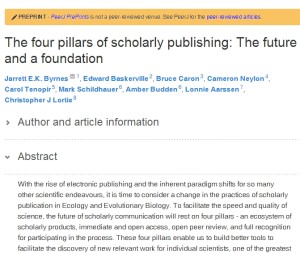Until the mid ’90s, the scientific communication flow followed the classic sequence model of writing, reviewing, publishing, indexing, and disseminating, where the focus of the process was printed scientific journals. With the advent of Internet, however, this flow begins to occur in the digital format, in a non-sequential way, where the Web is the medium where all processes converge, and authors, reviewers, editors and readers interact dynamically. The Web also facilitated the rising of new products and forms of scholarly communication.
Since then, the processes involved in the steps of scientific publishing, from data collection by researchers until publishing in an online journal is undergoing deep changes which transcend the simple change from the printed to the online version of a journal. Movements such as Open Access, which emerged in developed countries at the beginning of years 2000, the creation of thematic and institutional articles repositories and new forms to conduct the peer review process impose a new optics over scholarly communication all over the world.
Byrnes et al. (2013) propose a debate on what they call the four pillars for a more open future of scientific communication: a widening of our definition of scholarly products; immediate open access to these products at the start of their assessment and refinement; open public review for scholarly products; and an improved ability to assess scholarly products and the overall contributions of scholars. The authors identify that these pillars have a common ground on the need to converge the products that will help to increase the speed and quality of the scientific endeavor.
The program of the SciELO 15 Years Conference aligns with this debate.
An Ecosystem of Scholarly Products
The research product that presents greater recognition by the academic community is the scientific article. It is a monoculture under which other products and forms of communication which is acquiring an important role in research communication such as blogs, software, data visualization systems, workflows, etc. are considered second class products and are not formally recognized in academic records. As all these products contribute to the communication of research results, this situation should change for the advancement of science.
Immediate access
The peer review process is as old as the first scholarly publications of the seventeenth century and is the essential component of scientific communication until the present day, as it ensures the quality of communication and progress of scientific knowledge. The appraisal work, however, is time consuming and can take from a few weeks to years, as are part of the equation the number (always growing) of existing journals, the number of potential referees, the prestige of the journal, and the quality of the assessment. The slowness of this step that is the most critical of the publishing process can cause numerous harmful consequences to the authors and to all who directly or indirectly benefit from the knowledge generated by scientific research.
In order to provide an answer to this question, researchers in ecology and evolutionary biology have created the PeerJ initiative, a publisher of Open Access scholarly articles, similar to PLoS ONE and the physics, mathematics, and computer science articles repository, arXiv. PeerJ aims to reduce publishing costs and improve the scientific communication process by providing authors with an Open Access publishing channel which is dynamic and flexible. Besides PeerJ whose articles are subjected to peer review, the initiative also has a repository PeerJPreprints in which authors can submit their manuscripts in draft form and receive comments and suggestions from other authors, and once completed, can be submitted to the journal. These initiatives share the publishing policy based not on impact or innovation, but in sound methodology, scientific accuracy and editorial integrity.
Byrnes et al. (2013), as evidenced by the publication of the referred article in PeerJPreprints, believe that the immediate availability of scientific production that has not yet been submitted to peer review in articles repository is the cornerstone of the future of academic publishing, especially for allowing the rapid dissemination of knowledge.
Open review
Editors have in their hands the decision to define the peer review process of their journals. The most common formats are called blind, where the reviewer remains anonymous, but has access to the names and affiliations of the authors and the so-called double-blind assessment, in which referees and authors remain anonymous. With anonymity, the referee has the freedom to make comments and criticisms, or even reject a paper more freely, without fearing embarrassment or reprisal.
This process, however, as stated earlier, is time consuming and has many disadvantages, because it is not free from prejudice, personal issues or rivalry, bad judgment or bias, often unintentional (Ho et al., 2013). An alternative proposed by Kriegeskorte (2012) is the open assessment, by analogy to the expression Open Access. This type of assessment consists on publishing the reviews as part of the article or on Web pages or blogs maintained by the journal, and has the advantage of recognizing the thorough and specialized analytical work by the referee, who ends up discarded when the editorial process is completed. This format would also serve to give due credit to the researchers who devote their knowledge and time in an unpaid activity essential to scholarly communication. Some journals like PloS ONE, F100 Research and PeerJ now offer authors the option of publishing the comments of the referees.
Full Reputation and Recognition
The quality of scientific articles involves research methodology, good writing, a thorough evaluation and the overall view of the editor who has the final say on the publication.
The intellectual contribution to the article made by the referee is of great importance among the variables listed above; however, this contribution is not always of the expected quality. The open evaluation process aims to make a public recognition of reviewers and to their quality assessments, those who contribute significantly and positively to improve the quality of the articles. Therefore, a wide-ranging debate involving more actors than two or three reviewers and closed evaluations may take place, which the whole scientific community will benefit, especially reviewers and the peer-review system.
These four pillars, conclude the authors, will contribute to a faster discovery system of information and a more intellectually vibrant science.
References
BYRNES., et al. The four pillars of scholarly publishing: the future and a foundation. PeerJ PrePrints, 2013, vol. 1, p. e11v1. [cited 29 July 2013] Available from: http://dx.doi.org/10.7287/peerj.preprints.11v1
HO, R.C., MAK, K.K., TAO, R., LU, Y., DAY, J.R. and PAN, F. Views on the peer review system of biomedical journals: an online survey of academics from high-ranking universities.
BMC Med Res Methodol, 2013, vol. 13, p. 74. [cited 29 July 2013] Available from: http://www.ncbi.nlm.nih.gov/pmc/articles/PMC3685540/?tool=pubmed
IOANNIDIS, J.A. Effect of the statistical significance of results on the time to completion and publication of randomized efficacy trials. JAMA: The Journal of the American Medical Association, 1998, vol. 279, p. 281–286.
KRIEGESKORTE, N. Open evaluation: a vision for entirely transparent post-publication peer review and rating for science. Frontiers in computational neuroscience, 2012, vol. 6, p. 79. [cited 29 July 2013] Available from: http://www.frontiersin.org/Computational_Neuroscience/10.3389/fncom.2012.00079/full
ONITILO, A. A., ENGEL J. M., SALZMAN-SCOTT, S. A., STANKOWSKI, R. V. and DOI, S. A. R.
Reliability of Reviewer Ratings in the Manuscript Peer Review Process: An Opportunity for Improvement. Account Res., 2013, vol. 20, nº. 4, p. 270-284. Available from: doi: 10.1080/08989621.2013.804345.
 About Lilian Nassi-Calò
About Lilian Nassi-Calò
Lilian Nassi-Calò studied chemistry at Instituto de Química – USP, holds a doctorate in Biochemistry by the same institution and a post-doctorate as an Alexander von Humboldt fellow in Wuerzburg, Germany. After her studies, she was a professor and researcher at IQ-USP. She also worked as an industrial chemist and presently she is Coordinator of Scientific Communication at BIREME/PAHO/WHO and a collaborator of SciELO.
Como citar este post [ISO 690/2010]:

















Pingback: EdUNEB – Editora da UNEB » Blog Archive » Artigo propõe quatro pilares para a comunicação científica favorecer a velocidade e a qualidade da ciência